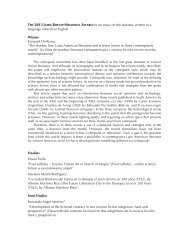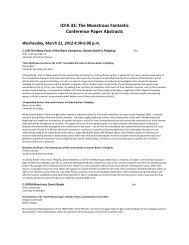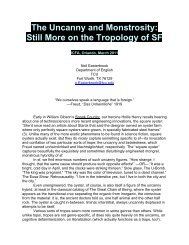dynamics as point out how queer the story has always been. I will elaborate this thesis by analyzing how Olaf Stapledon’s Sirius further exploresand articulates the queer potential of Shelley’s novel, both in its critical interrogation of hetero-normative sexuality and in its deconstruction ofthe categories of the person and the human.From Darkness into Light: Science Fiction, Horror, and H. G. Well's <strong>The</strong> Island of Dr. MoreauDavid BañuelosUniversity of California, RiversideMany works generally classified as science fiction also strongly demonstrate qualities of the horror genre. Such "borderline" cases can beparticularly useful in understanding how these different genres function. One such borderline case is H. G. Well's <strong>The</strong> Island of Dr. Moreau,which combines elements such as cognition, estrangement, ambiguity, terror, horror, the monstrous, the grotesque, and the sublime. <strong>The</strong>content, structure, and style of this novel all combine elements of science fiction and horror into a complex, but unified, whole. <strong>The</strong> beast menare almost perfect examples of the science-fictional grotesque, except that their scientific origins are not revealed until the story is half-wayover. This renders them more terrifying then cognitively estranging. When we finally understand what the beast men truly are, they becomescience-fictionally sublime, while remaining grotesque. Like Frankenstein's creature, the beast men are sublime in that they demonstrate theamazing power of the human intellect, to create beings so like humans, and grotesque in that they seem to violate the normal laws of "nature."Throughout the story, we see information omitted or concealed, while the protagonist, Prendick, unlike the typical science fiction protagonist,takes little initiative in uncovering the truth. He either chooses not to ask seemingly important questions, or if he does ask, his questions aredeflected, answered with lies, or completely ignored. Prendick usually accepts these evasions rather than persist in his questioning. Thus,Prendick, and we the readers, are left in a state of terror, rather than cognitive estrangement. By combining science fiction and horror, <strong>The</strong>Island of Dr. Moreau produces intellectual and aesthetic effects that neither could achieve alone.<strong>The</strong> Dynamo Poets and the Monstrosity of Industrial CapitalismBrian McAllisterAlbany State UniversityThis paper explores the development of a set of tropes employed by a group of leftist poets of the 1930’s who were associated with Dynamo: AJournal of Revolutionary Poetry particularly Kenneth Fearing, Sol Funaroff, Edwin Rolfe, and Muriel Rukeyser. This is an under-appreciatedgroup of writers who grew out of the so-called proletarian school of poets in the 1920’s to form a school of poetics antithetical to the prevailingtaste for imagism. As self-professed outsiders both in aesthetics and in politics they appropriated and expanded, sometimes to a fantasticextent, a number of beast metaphors found in progressive writing of the time. American literature of the late nineteenth and earlytwentieth centuries, especially literature of progressive political stance, employed a variety of animal tropes to depict the evils of moderncapitalism. For example, we are all familiar with the comparison of the railroad companies to an octopus most memorably deployed in FrankNorris’s 1901 novel. An octopus was an apt metaphor for a corporation that spread its tentacles across the country and into every otherbusiness that it touched. Less well known is Vachel lindsay’s use of feline imagery to describe the machinery of big business—locomotives andpump engines, for example. Lindsay’s machines are ominous crouching beasts with insatiable appetites that demand obeisance from thosewho serve them. <strong>The</strong>se images and others were expanded in the hands of the Dynamo poets to create a monster of Industrial Capitalism.Especially culminating in the work of Edwin Rolfe, this monster becomes a kind of gargantuan zombie whose body is literally made up of theremains of workers it has first forced to do its bidding and then consumed.128. (CYA) <strong>The</strong> Line Between the Human and the Monster MapleChair: Leisa ClarkUniversity of South Florida"My, my, there are always monsters!”: <strong>The</strong> Conflation of Monstrosity and Humanity in D.M. Cornish’s Monster Blood Tattoo TrilogyDaryl Ritchot<strong>The</strong> University of British Columbia OkanaganIn D. M. Cornish's Monster Blood Tattoo Trilogy readers are transported to the Half-Continent, a neo-Victorian world where monsters of variousshapes and sizes wander the wilderness and wreak havoc on humanity. Life on the Half-Continent revolves around these monsters and ways toprotect humanity from the dangers they represent. However, when Rossamünd Bookchild, the foundling protagonist of the series, leaves theorphanage to embark on his adult life both he and the reader learn that monsters and humans are really not as different as is generally thoughton the Half-Continent: some monsters are shown to be helpful and harmless while some humans, specifically the monster hunters known aslahzars, are shown to be little more than the indiscriminate killers which they are supposed to hunt. In this paper I will both question ourconception of monstrosity and explore how the monstrous alters our idea of what it means to be human. My exploration will be grounded inthe theory of the monstrous put forth by Richard Kearney in Strangers, Gods and Monsters: Interpreting Otherness. Specifically, that whilemonsters are a representation of evil from without, they are also an externalization of the evils that humans themselves possess. Furthermore,I will supplement my examination of the lahzars by reading them through discourses from posthumanism, most notably the cyborg theory ofDonna Haraway. As a result of the lahzars having artificial glands and organs implanted within their bodies to grant them “superpowers” to aidin their fight against monsters, many people fear the lahzars almost as much as they fear monsters: these enhancements turn them intopseudo-monsters. By examining the conflation of humans and monsters within these novels I will show that neither humans nor monstersshould be judged on their race and appearance but on their actions.<strong>The</strong> Human Monster: Redemptive (Im)possibilities in <strong>The</strong> House of the Scorpion and Rot & RuinDorothy Karlin
Simmons CollegeIn the spate of recent Y.A. dystopias, novels often depict atrocities, but they credit people with effecting the monstrous. I wish to engage withJonathan Maberry’s Rot & Ruin (2010) and Nancy Farmer’s <strong>The</strong> House of the Scorpion (2002); both novels include corporeal grossness butshowcase repellant human behavior. While Baldick defines the horror story as one that “focuses upon the violation of physical taboos,” bothRot & Ruin and <strong>The</strong> House of the Scorpion focus upon the violation of moral and ethical taboos. In the former, the bounty hunters inspire morerepulsion than the undead, and in the latter, El Patrón oppresses all residents of Opium. <strong>The</strong> novels inspire revulsion less through rotting fleshand other trappings of horror than through their overarching discussions of human behavior in worlds without appropriate moralbases.Although these novels locate the monstrous in the human, they try not to make it inherent to humanity. Instead, they particularize evil.Each novel has a delocalized menace – the lawlessness of the Rot and Ruin and the dehumanizing potential of science enacted in Opium – buteach distills that threat into more discrete, and therefore surmountable, enemies. Benny Imura can beat Charlie Pinkeye and <strong>The</strong> Motor CityHammer, and Matt Alacrán can help destroy El Patrón and dismantle his empire. Using Romantic plots, in which individual heroes defeat evilvillains, the novels attempt to contain the monstrous and glorify the human. <strong>The</strong>y compromise that containment, however, by having initiallycombined the two. Is it enough that Benny and his brother, Tom, have noble thoughts and intentions, if they slaughter zombies wholesale whenthreatened? As El Patrón’s clone, can Matt escape inheriting his genitor’s negative qualities? According to these novels, what does it mean tobe human, and can that differ from being humane?<strong>The</strong> Passion of the Cullen: Blood(lust), Transubstantiation, and Mortification in Stephenie Meyer's Edward CullenAmanda FirestoneUniversity of South FloridaEdward Cullen is a vampire with a moral dilemma. In his own words: “I don’t want to be a monster” (Meyer, Midnight Sun 204). But that’sprecisely what vampires are, right? For centuries myths about unnatural, blood drinking fiends have followed humans, plaguing theirnightmares. For the hero of Stephenie Meyer’s Twilight Saga, this simple fact causes a great deal of consternation. Edward’s bloodlust, whichhe calls “the monster,” is posited as a demon that he constantly battles (Meyer, Midnight Sun 10). In the diegesis of the text, Edward frames hisbloodlust as something monstrous. His body craves human blood and drinking it would be well within the confines of his nature, but heconsciously abstains. However, it’s not enough to abstain; Edward must persistently punish himself for his bloodlust. He drinks animal blood asa substitute and participates in masochistic behaviors like remaining near Bella Swan’s blood. Edward’s behaviors speak to theories KennethBurke presents throughout his oeuvre concerning transubstantiation, guilt, scapegoating, and mortification. <strong>The</strong>se concepts create aconversation about how people symbolically deal with guilt and the various methods for purgation and purification. Burke entreats readers tothink of literature as “equipment for living,” where novels act as extended proverbs (Burke, <strong>The</strong> Philosophy of Literary Form 293). We begin torecognize that literature functions as a prescriptive tool for teaching behavior (Burke, the Philosophy of Literary Form 293, 296). <strong>The</strong> strugglewith Edward’s bloodlust is the symbolic representation of sin. I analyze Edward’s specific sin – lust – and his guilt cycle as it changes from apurification of general sin to one concerning the denial of sexuality. By tracing Edward’s human and vampire histories, I shed light on thepossibilities for his motivations pertaining to his morality; in turn, I speculate what the potential subtextual prescriptions are for readerspertaining to their own moralities as embedded in the text by Meyer.129. (FTV/SF) Monstrosity and Ideology in Battlestar Galactica CypressChair: J.P. TelotteGeorgia TechGiving a Human Face to Monsters: Violence and Ethics in Battlestar Galactica and VAino-Kaisa KoistinenUniversity of OuluIn my paper I aim to discuss violence and ethics in the TV-series Battlestar Galactica (BSG) and V, mostly concentrating on the re-imaginedversions (BSG USA/UK 2003-2009, V USA 2009-2011). Both series represent a war between humans and their “alien others”. However, as theseries progress the reasons for the war become more and more complex, which blurs the boundaries between “us” (humans) and “the others”(the aliens/enemies). This is especially negotiated in the scenes discussingtorture and violence. My analysis connects the series to theoreticaldebates that consider meeting others ethically, as put forward in the work of Judith Butler and Sara Ahmed. According to Butler, during war,lives are divided into grievable and ungrievable ones (Butler 2006: e.g. 28–39). Drawing on Butler, Ahmed has asked: “What happens whenthose who have been designated as ungrievable are grieved, and when their loss is not only felt as loss, but becomes a symbol of the injusticeof loss?” (Ahmed 2004: 192). I argue that BSG and V both address this question: as the “alien others” – i.e. the monsters– appear human andsometimes even act more ethically – or humanely – than the humans, the“monsters” are truly given a human face and the distinctions betweenungrievable and grievable lives become uncertain. I will discuss the series in relation to contemporary phenomena such as racism andxenophobia. Representations both reflect and construct the world they are produced in (e.g. Kellner 1995: 1–11) and the human-like others inBSG and V take part in the production of the signifying practices that mark what is to be regarded as human and non-human, and as suchprovide tell-tale signposts for identity formation in our collective social imagination. Thus, what gets to count as human, or not, in fiction is alsotelling of lived identities that are made possible in everyday life. (I will probably prepare a PowerPoint presentation.)Monstrosity and Ideology in Battlestar GalacticaVan LeavenworthUmeå University
- Page 4 and 5:
5. (F) Wondrous Bodies of the Gende
- Page 6 and 7:
Fantastic Suicide: Reading the Unca
- Page 8:
Viral Posthumanism: Boundaries and
- Page 11 and 12:
The Concept of Soul Divisibility in
- Page 13 and 14:
Thursday, March 22, 2012 10:30 a.m.
- Page 15 and 16:
21. (CYA) Terrifying Futures: Post-
- Page 17 and 18:
23. (FTV/H) Now I’m Feelin’ Zom
- Page 19 and 20:
Fight Club: Amalgam of the Horrific
- Page 21 and 22:
Taking the Monsters out of the Clos
- Page 23 and 24:
Kaspar J. SaxenaIndependent Scholar
- Page 25 and 26:
44. (CYA) The Monstrosity of Teenag
- Page 27 and 28: 46. (FTV/SF) Monstrous Spin-offs: T
- Page 29 and 30: 49. (F) Aspects of Miéville Captiv
- Page 31 and 32: 53. (SF) War and Crisis in 1940s an
- Page 33 and 34: Abuse of Power: An Evolutionary Res
- Page 35 and 36: Disappearing Natives: The Colonized
- Page 37 and 38: 60. (H/IF) Ancient and Medieval Mon
- Page 39 and 40: 62. (F) The Works of Tolkien Captiv
- Page 41 and 42: 67. (SF) Imperial and Postcolonial
- Page 43 and 44: Beheading the Gorgon: Beautifying C
- Page 45 and 46: 71. (VPA) Monstrous Music MagnoliaC
- Page 47 and 48: 73. (F/IF) Portraying New Worlds Ca
- Page 49 and 50: Friday, March 23, 2012 2:45-3:45 pm
- Page 51 and 52: 81. (FTV) Those Damn Dirty Apes! Cy
- Page 53 and 54: Friday, March 23, 2012 4:00-5:30 pm
- Page 55 and 56: 92. (F) Leaving the Demonized Other
- Page 57 and 58: 94. (FTV/CYA) Monstrosity and Devia
- Page 59 and 60: of cannibalism, ghostly seduction i
- Page 61 and 62: Saturday March 24, 2012 8:30-10:00
- Page 63 and 64: 104. (CYA) Classic Monsters, Reinte
- Page 65 and 66: 107. (VPA) Monstrous Gaming Bodies
- Page 67 and 68: who challenge the order that the Br
- Page 69 and 70: Reading Between the Times: A Critic
- Page 71 and 72: 117. (FTV) Monsters and Superheroes
- Page 73 and 74: 119. (IF/H/PCS) International Mash-
- Page 75 and 76: Focusing on Stoker's Dracula as one
- Page 77: Florida Atlantic UniversitySheri S.
- Page 81 and 82: Independent ScholarKing’s story
- Page 83 and 84: modernity opens up for every indivi
- Page 85 and 86: Saturday March 24, 2012 4:00-5:30 p
- Page 87 and 88: 141. (FTV) Monstrous Masculinity Cy
- Page 89 and 90: ultimately make peace with her mons
- Page 91 and 92: where the almost-human sentient zom





